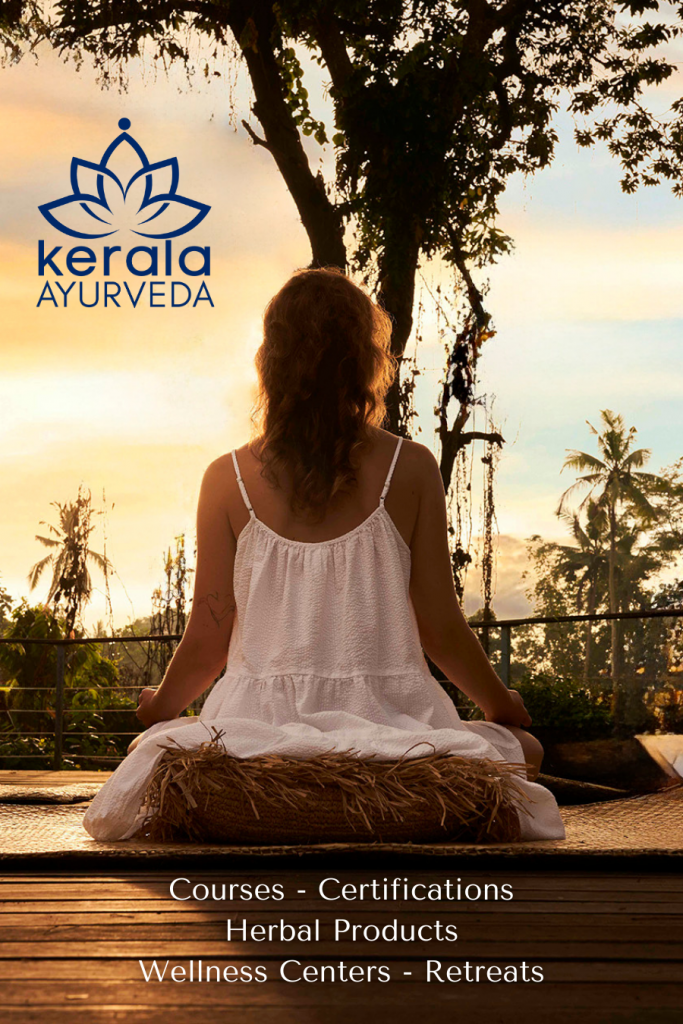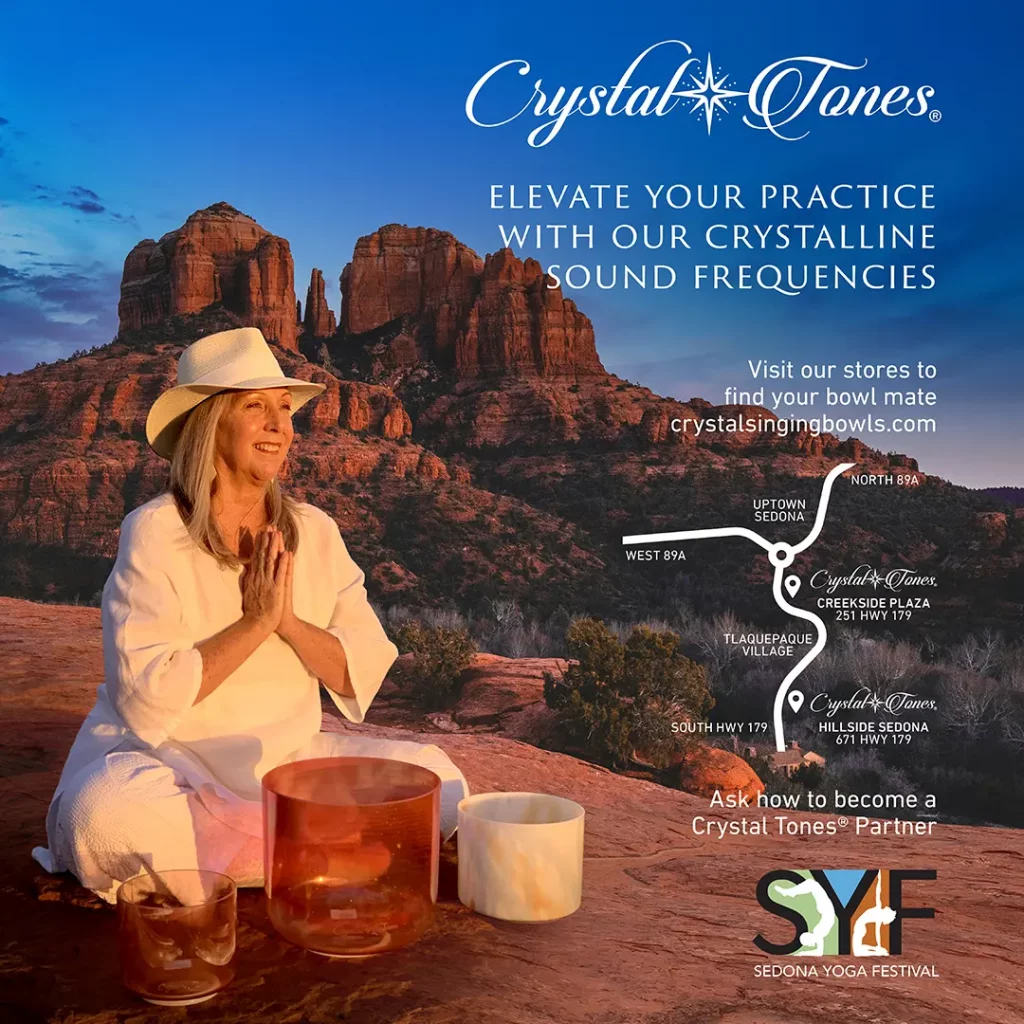Feb 3, 2014 | Sedona Yoga, Yoga Festival, Yoga Festival Experience

- Amara Resort and Spa
We are proud to work with many sensational Sedona venues and after taking the final walk-throughs and measurements, we couldn’t help but share the exquisite beauty that honors Sedona in all of her glory. Each location holds an incredible space for transformation, growth, imagination, exploration and creativity.
Come take a look with us and plan your SYF2014 Transformation!!
Salt water hot tub burrowed in the salt water infinity pool nestled cozily above the creek at Amara Resort and Spa. Here you can catch Pamela Quinn’s Ayurvedic workshops, Barbara Matsura’s Qigong’s Ba Duan Jin classes, and Robert Sturman’s Yoga Photography classes.
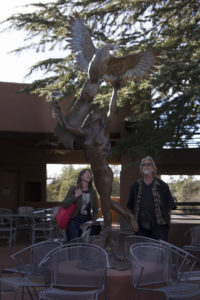
- Heather admiring one of John’s many phenomenal bronze sculptures that highlight the Sedona Creative Life Center.
Sedona Creative Life Center. Dedicated to creativity, fulfillment, growth and coming together in a diverse spiritual community for personal spiritual advancement, the Creative Life Center offers magical views of Sedona, beautiful spaces to gather and lifting rooms for learning. Home of our Mindful Therapeutic Yoga Practices for Veteran’s 2-day Intensive Training for Yoga Teachers, You’ll get to enjoy a healing meditative sonic journey on Saturday evening with East Forest from 7pm-10pm. Mark Whitwell presents Sunday morning as we move into Sarah McLean’s Meditation Gathering for World Peace at 1pm.

Start your mornings off right at 7 Centers Yoga Arts. Each morning there will be a Morning Sunrise Agni Hotra and Meditation at 7am with Ruth Hartung. There are many fulfilling classes here, Shelly Prosko’s “Happy Hearts Healthy Backs”, Liz Tucker’s “Bhavana in Motion” and Julia Mick’s “Biology of Ecstasy”. Sunday sit with Rama Jyoti Vernon for the World Peace Meditation at 1pm as Sarah McLean leads the broadcast Live to the World!

SYF 2014 Staff hard at work visualizing the magic and music that will unfold at the Sedona Rouge Hotel and Space. Starting Friday off, we have Barbara Matsuura’s “Sheng Zhen Gong, Unconditional Love Practice”, Saturday Stephanie Colletti gets our chakras dancing in her, “A SOULful , Whole-Being Healing Experience” and Sunday, Ana Brett and Ravi Singh encourages us to balance those crucial “glandular go-getters” in their, “Happy Hormones: Kundanlini Yoga” class with live gong music!

- Agave’s Terrace
Agave of Sedona is walking distance from our thriving Heart Center Vendor Village and home to one of the most breath-taking views here in West Sedona. Himalayan Institute’s Luke Ketterhagen will be teaching his class, “Agni Sara, The Master Practice” here, where you are sure to become the energy, light and transformative qualities of fire in this strengthening class. Finishing Friday off, Marguerite Baca will have us laughing, dancing with Outlaw Yoga and spinning fire with SYF’s Artistic Director, Matthew Hunsaker and tribe! This is where I’ll be Friday night, for sure!!
That’s just a few venues for now! Stay tuned for more visually stimulating captures that will be caught by our team of photographers and active participants!
Jan 14, 2014 | Sedona Yoga, Sedona Yoga Retreat, Yoga Conference, Yoga Festival Experience
 Building on the tremendous success of their inaugural festival last year, organizers of the highly anticipated Sedona Yoga Festival are gearing up for another truly transformative event early next month. Thursday–Sunday, February 6–10, yogis and other conscious community members will flock to the quiet boulevards and soaring red rock canyons of Sedona for three days of yoga, music and energy work in the undisputed spiritual center of the American West.
Building on the tremendous success of their inaugural festival last year, organizers of the highly anticipated Sedona Yoga Festival are gearing up for another truly transformative event early next month. Thursday–Sunday, February 6–10, yogis and other conscious community members will flock to the quiet boulevards and soaring red rock canyons of Sedona for three days of yoga, music and energy work in the undisputed spiritual center of the American West.
For attendees, it’s an unprecedented opportunity for powerful personal growth—in a destination unlike any other. Unlike larger corporate-sponsorship yoga conferences, held in large central facilities with cavernous rooms and hundreds of attendees per class, the Sedona Yoga Festival schedule was developed specifically with the city’s quaint, homey atmosphere in mind. 200+ classes, workshops and events are sprinkled over 21 intimate local venues, with convenient shuttle service available and a variety of lodging options close at hand.

Presenter Cat Arena at Amara Resort
The flexible conference structure gives yogis the chance to weave their own experience in the richly colored cultural and natural tapestry of Sedona. Workshops and music are everywhere—spas, yoga studios, ballrooms, banquet halls, movie theaters, chapels and beyond. At the hub of this creative collective is Heart Center Village, a lively central gathering and registration area where participants can share the festival experience with yoga, healthy food and drink, conscious vendors, live music, listening lounges and a host of free, open-to-public activities.
The event’s esteemed faculty is widely varied and deeply experienced—and, befitting the destination, utterly down to Earth. Presenters were chosen not purely for their marquis-friendly names, but for the richly layered credentials, commitment to consciousness and unfailing authenticity that resonate in Sedona’s spiritually charged environment. Among them are acclaimed author/teacher Mark Whitwell, Yoga Journal Co-Founder Rama Vernon, Kundalini masters Ana Brett and Ravi Singh, best-selling spiritual author Sunny Dawn Johnston and more than 100 yogis, healers, artists, authors, musicians, shamans, scientists, philosophers and performers.
 Together, the festival’s 108 presenters will facilitate more than 200 classes, workshops and events, from Yoga Nidra to Ecstatic Dance and just about everything in between. Conference attendees are also encouraged to set aside time for the exploration and contemplation of their surroundings, which include some of the most breathtaking high desert landscapes in the world. With more than four million annual visitors, Sedona is a virtual mecca for hikers, bikers, artists and spiritual seekers. Rich in energy “vortexes,” the area has long been known for its inspiring, regenerative powers—making it the ideal place to take one’s practice to the next level.
Together, the festival’s 108 presenters will facilitate more than 200 classes, workshops and events, from Yoga Nidra to Ecstatic Dance and just about everything in between. Conference attendees are also encouraged to set aside time for the exploration and contemplation of their surroundings, which include some of the most breathtaking high desert landscapes in the world. With more than four million annual visitors, Sedona is a virtual mecca for hikers, bikers, artists and spiritual seekers. Rich in energy “vortexes,” the area has long been known for its inspiring, regenerative powers—making it the ideal place to take one’s practice to the next level.
“Sedona is such an inspirational place, and so closely aligned with the principles of any yogic, spiritual or consciousness practice. It seemed incredible that there wasn’t already a festival here—or indeed a cohesive yoga offering we could share with the world.” said Marc Titus, SYF Founder and Director. “We are so honored to be helping to fill that gap as we bring the yoga community hOMe to Sedona.” In keeping with the spirit of seva, SYF is donating a portion of conference proceeds to the Give Back Yoga Foundation, a non-profit organization dedicated to supporting yoga teachers in the offering of service to their communities.
SYF2014 kicks off at 6:30 p.m. on Thursday, February 6. click here for complete conference schedules or click here to purchase tickets.

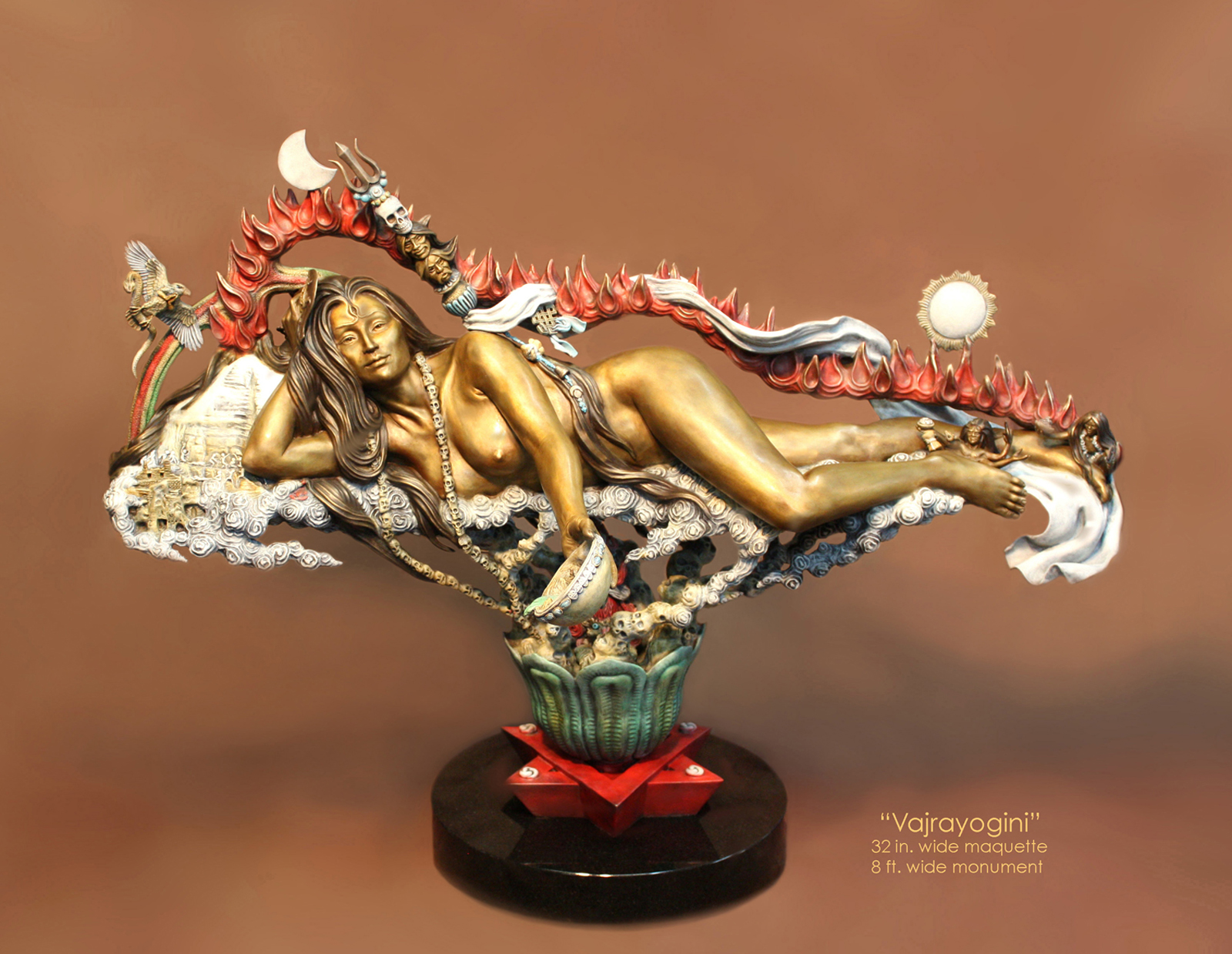
Jan 12, 2014 | Yoga Conference, Yoga Festival Experience, Yoga Philosophy
John M. Soderberg spent the first 18 years of his life in Central and Southeast Asia, and circled the world eight times before graduating high school in Bangkok, Thailand. Gil Gillenwater has travelled much of his life, and among many other countries, extensively studied and explored in Tibet. Both, in their own way, have been fascinated by, and explored, the human experience.
John became one of the earliest members of Gil’s Rancho Feliz Charitable Foundation, and they have worked together on numerous humanitarian projects and charitable efforts. After Gil’s latest immersion in Tibetan culture and sacred landscape, he told John of his experiences and invited him to sculpt the highest female in Tibetan Buddhism—the goddess Vajrayogini.
John had been moved for some time to work in that direction, and Gil formally commissioned him to sculpt her. They worked together for three years designing this sculpture and all of the elements involved, as John sculpted her. In the truest sense of the word, Vajrayogini evolved. This evolution began in the early lives of John and Gil, in their explorations, interests and growth, and continued through their design partnership. Following, in their own words, is an introduction to this creation.
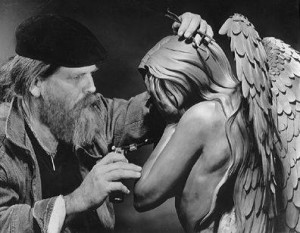 John M. Soderberg: “I was six or seven years old when the Dalai Lama came to Kashmir. He came, with his court, to see the film about the Christian holy-man Moses, “The Ten Commandments,” with Charleton Heston. I was living at the time with my family on a carved wooden houseboat on Lake Dal, in Northern India, and we also went to the movie, at the same time. I still vividly remember his face as he smiled at me in the gardens outside the theater.
John M. Soderberg: “I was six or seven years old when the Dalai Lama came to Kashmir. He came, with his court, to see the film about the Christian holy-man Moses, “The Ten Commandments,” with Charleton Heston. I was living at the time with my family on a carved wooden houseboat on Lake Dal, in Northern India, and we also went to the movie, at the same time. I still vividly remember his face as he smiled at me in the gardens outside the theater.
In the 1940s, the king of Afghanistan commissioned my father, a civil engineer from Cal Tech and UCLA, to build and direct the first engineering school in that country. My parents travelled across Asia two years after the end of World War 2, and after several life-threatening adventures, arrived in Kabul. I spent the first five years of my life there, where I sculpted in mud and clay, and from the age of four, painted with my father’s oils.
The Afghan Institute of Technology was running successfully, so my family then moved to New Delhi, India for six years. We spent much of that time travelling and exploring from Sri Lanka to Madras, Calcutta, Srinigar, Assam, Nepal, and Kulu Valley in the north. International attention was on India in the late ‘50s, and I met President Eisenhower, Prince Phillip, Prime Minister Nikita Krushchev, others, and had tea with Prime Minister Jawaharal Nehru in the palace, at age seven. The art of India marked me deeply. From the classical art of Europe to the carvings on the ancient forgotten temples my brothers and I found and explored in the jungles and forests of India, to the intricate sculpture in the bazaars, and the story-telling paintings of the Ramayana, I discovered my passion. Every Sunday in New Delhi, Tibetan gypsies would show up in front of our home and spread out a blanket on the driveway. From bulging sacks, they would pull out pots, jewelry, ceremonial knives, and sculptures in jade, wood, and silver, and arrange everything in rows on the blanket. I would spend hours holding and studying the art.
When I was eight years old, my family and I rode on horse-back from northern India up to the foothills of the Himalayas, and the glaciers. We rode for several weeks, sleeping in small dak bungalows in mountain meadows. We rounded up our horses in the mornings after breakfast around a fire, and rode on. The beauty was immense. Two months later, I stood alone inside the Taj Mahal, next to her marble resting place, at midnight with a full moon.
When I was 11, we moved to Thailand. At 12, I began studying teakwood carving with the country’s leading master, a Buddhist monk. Every weekend, we would set up in old-town Bangkok near the 90 feet long reclining Buddha, and carve all day on Buddhist angels, dragons, and mythical or traditional figures. The master would speak as we worked of his childhood, of Buddhism, and of art. My high-school was The International School of Bangkok. We had over 90 nationalities represented, and for a time my girlfriend was a Cambodian Buddhist.
I studied various martial arts from age 13 or so. I studied with Koreans, Japanese, Americans, and Thais, and made my first black-belt by age 17. It was an important time in my development, as an artist and as a student of humanity. From the earliest time I can remember, I have been fascinated by people, and have been drawn to philosophy and psychology. I have been most led to those essential human elements which serve to unify people over the superficial barriers which too often separate them. The evolution of my art has been to document and explore the essence of humanity, and this led me to service-work in the early 70s.
After high school, I flew to America in the late 60s for college in Washington State. Due to extreme culture shock, and late-60s shock, I dropped out of college, and ended up painting in oils for a year on the street in Berkeley, California, during the People’s Park riots. After several near-death experiences, I figured it would be safer joining the Marine Corps, and going home to Southeast Asia. The military, in its wisdom, instead sent me to Arizona, where I taught martial arts and worked in electronics with a missile battalion. I became involved with service-work, doing drug counseling, and helping others through delayed stress syndrome from combat in Vietnam.
After my Honorable Discharge in 1973, I worked as a machinist, made sculpted jewelry, (including a bracelet for Elvis Presley,) and painted. I expanded my volunteerism, becoming involved with charitable groups in Phoenix, which focused on women and children in need.
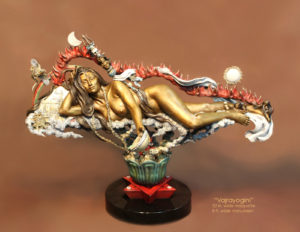
Bronze Sculpture, 2009, by John M. Soderberg, Ph.D.
Designed by John M. Soderberg and Gil Gillenwater
Commissioned by Gil Gillenwater
In 1976 I committed the rest of my life to professional bronze sculpture and have continued to expand my service involvement. I have used my work to benefit numerous organizations including Amnesty International, Rancho Feliz, Free the Slaves Organization, one of the Paul Newman Hole-In-The Wall-Gang camps for seriously ill children, domestic abuse shelters, Big Brother, Big Sisters, The Advancement of Women for Northern Arizona University, community service clubs, and other causes. In 1998 I received my Ph.D. in Humane Letters, and a year later I was Knighted by a Swedish Count for service-work and art achievement.
I have sculpted numerous historically influential figures including Christ, Moses, Merlin, Norman Vincent Peale, Gil Gillenwater, Billy Graham, Archbishop Fulton Sheen, Sacajawea, St. Catherine of Siena, Stephen Biko, Poseidon, various corporate founders, inventors, and others. I have sculpted several Asian-themed pieces over the years, but for some time have felt a strong pull to sculpturally explore the influences of my childhood. I have begun this process with the bronze “Vajrayogini.” It feels very good to come home.”
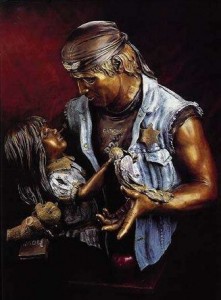
Gil Gillenwater – Founder & President, Rancho Feliz
Gil Gillenwater “I am a life-long resident of Scottsdale, Arizona. I am a yoga and meditation practitioner, an outdoorsman, a traveler and a black belt in Kenpo karate. In addition to this, or should I say because of this, I am also a philanthropist.
My interest in Buddhism and Eastern thought came directly through my fascination with the human mind. As an existentialist, I have always been intrigued with consciousness and our unique ability to create realities through the study and power of our minds.
My quest led me from positive thinking, to hypnotism, to Hinduism and eventually to Buddhist meditation master Chögyam Trungpa and his “Shambhala, the Sacred Path of the Warrior”. (Little did I know how prophetic the words “Shambhala” and “Warrior” would be in my life.) Discovering “service to others” as an ego-diminishing, fast-track to awareness, in 1987 I founded the Rancho Feliz Charitable Foundation, Inc. I have since devoted a major portion of my life to service. This is my chosen path to enlightenment. In 1993 I took my Bodhisattva vows from the Dalai Lama. In 2006 I founded the Guardian Warrior Foundation, Inc., a self-funded charity established to support Rancho Feliz and to promote its concepts on a global basis.
In 1999, I was a recipient of the Hon Kachina Award, Arizona’s highest honor for volunteerism. In 2000, I was one of five members throughout the United States chosen to receive the National Association of Realtors, “Good Neighbor Award”, likewise honoring volunteerismMy interest in Buddhism led me to Tibet in 1994. Obtaining some of the first permits to enter the forbidden Pemako region, my brother and I smuggled a 12 foot paddle raft into southeastern Tibet. Here, with two companions, we made a “first descent” attempt down the world’s highest, remotest and wildest river, the Yarlung TsangPo. This was my first of three ventures into the revered Beyul Pemako region – the “Hidden Land of the Blossoming Lotus”, the Shambhala of Tibet. It was here that I was introduced to the female Buddhist meditational deity – Vajrayogini.
Vajrayogini is represented geographically spread out over the Pemako region (as further explained in the description). Her practice is especially associated with the use of sexual energy to obtain enlightenment. As a man, I have always been fascinated by the female energy and the intuitive and compassionate energies it has to offer. I was hooked.
Returning to Pemako in 1995 and 1997, we undertook month long, leach-infested and extremely arduous pilgrimages/expeditions to Vajrayogini’s various terrestrial chakras. It was in 1995, during a particularly brutal portion of our trek that she appeared to me in a vision. However, instead of seeing her in the upright “Warrior Posture”, I saw her in the reclining posture of the Buddha. Also, instead of the stiff legged, rigid demeanor of a store front mannequin, she was soft and supple and invitingly gorgeous. (Historically, Vajrayogini, as a meditational deity, has been sculpted, painted and described by monks – men of limited knowledge of the female body.) The Vajrayogini I saw exuded power through her sexuality. The vision was stamped indelibly.
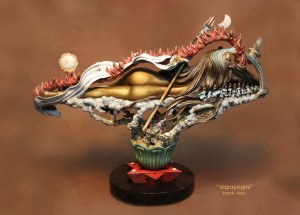
Bronze Sculpture, 2009, by John M. Soderberg, Ph.D.
Designed by John M. Soderberg and Gil Gillenwater
Commissioned by Gil Gillenwater
In 1997, my brother and I located Pemako’s long-sought “Lost Falls of the Brahmaputra” and were subsequently arrested by the Communist Chinese. However, that’s a different story and if you are interested you can learn more about it at: www.hiddenfalls.org
I have returned to the Himalayas three additional times visiting Vajrayogini’s holy locations in Nepal, Ladakh and Mt. Kailash of Tibet. It has long been my dream to find a way to convey my experiences and understandings in a unique and meaningful way. My artist friend and fellow Rancho Feliz “Guardian Warrior”, John Soderberg, has helped me do just that.
I worked with John for three years creating the “Reclining Vajrayogini” bronze. The piece is rich in symbolism and I know of no other sculptor who could have captured the essence of this feminine deity as did John. There is not a doubt in my mind that John was divinely inspired and guided in this creation. The Vajrayogini you see here is the self-same goddess who materialized before me in waterfall mists of the Hidden Lands.
It’s important to note that the many Buddhist concepts symbolized in this sculpture exist independent of Vajrayogini. Vajrayogini’s function is to rouse the kundalini energies in her practitioners. Once brought to the fore, these sexual energies can be harnessed as the force to propel us beyond our instinctual traps such as grasping, greed, hatred, self-centeredness, etc. to achieve spiritual perfection.
I chose Vajrayogini because I believe the genetic drive to reproduce is the strongest of all human instincts. Accordingly, as instinct driven as I am why not choose rocket fuel to propel me on my path to enlightenment!
Jan 10, 2014 | Sedona Yoga, SYF2014 Presenters, Yoga Festival Experience

Silvia Mordini sharing Happiness at SYF2014
The first yoga conference I’ve ever attended was the Midwest Yoga Conference organized by Jonny Kest about 10 years ago. Silvia Mordini
In all honesty, I was very nervous. I over thought what I’d wear, the brand of snacks or drinks I’d bring, even my time of arrival. I didn’t want to be too early and appear too eager even though to me this compared to a kid awaiting Christmas morning.
My expectation was that of personal and pose judgment from my fellow yogis combined with a deep concern for not being good enough to practice with the die-hards. And what’s worse, I was afraid to talk about it, as going to a yoga conference meant I was admitting to my yoga addiction.
What I found instead was no one paid any special or particular attention to me. It was easy to get lost in the crowd and simply practice my yoga. The sheer opportunity to learn from so many teachers all gathered in one place further propelled my enthusiasm for the practice.
Below are five reasons why you should go to a yoga festival:
Solo adventure:
It’s a chance to travel somewhere by yourself, facing uncertainty and growth all at once. It not only gets you out of your comfort zone but also your normal yoga clique.
Community:
It is a smart way to network with a lot of passionate yogis all in one place. So whether you are trying to grow awareness, establish your personal brand, or sell a yoga product; there’s no place more conducive to doing so. The joy of connecting face-to-face instead of via social media sites like Facebook or Twitter heightens the power for future collaboration.
Trends:
A yoga festival is a direct opportunity to see what is currently trending and popular in terms of clothing, style, music, sequencing, and much more.
Inspiration:
Learning new perspectives from a variety of geographically diverse teachers boosts our collective creative energies. You can’t help but feel the life-enhancing power of being a part of the creative process.
 Vacation:
Vacation:
A yoga festival or conference is not only partly a retreat but also a kind of yoga vacation. The locations offered this year alone are in beautiful parts of the world such as Bali, Whistler, Sedona, Arizona, Lake Tahoe, and Colorado. What better way to spend your time away from work than doing something you love and investing in your own personal growth and development?
By attending a festival you realize how yoga expands us spirituality by narrowing and focusing our world lens on the most meaningful human essentials: cooperation, kindness, love, and learning.
These shared qualities only get strengthened when we are with a cohort of other highly conscious individuals. The benefits of how elevated your spirit feels in the post yoga festival high last far beyond your last workshop. The knowledge and experience you gain will last a lifetime.
What festivals are on your agenda? What are you most excited for?
Read the article originally posted on YOGANONYMOUS by clicking here:
Below are the 5 Reasons why you should go to a Yoga Festival, By Silvia Mordini
SILVIA CAN BE REACHED:
Web: www.alchemytours.com or www.silviamordini.com
Email at silvia@alchemytours.com
Twitter @alchemytours @inspiredyogagal
Facebook Silvia Mordini (https://www.facebook.com/profile.php?id=1164596386)
Instagram inspiredyogagal








 Building on the tremendous success of their inaugural festival last year, organizers of the highly anticipated Sedona Yoga Festival are gearing up for another truly transformative event early next month. Thursday–Sunday, February 6–10, yogis and other conscious community members will flock to the quiet boulevards and soaring red rock canyons of Sedona for three days of yoga, music and energy work in the undisputed spiritual center of the American West.
Building on the tremendous success of their inaugural festival last year, organizers of the highly anticipated Sedona Yoga Festival are gearing up for another truly transformative event early next month. Thursday–Sunday, February 6–10, yogis and other conscious community members will flock to the quiet boulevards and soaring red rock canyons of Sedona for three days of yoga, music and energy work in the undisputed spiritual center of the American West.
 Together, the festival’s 108 presenters will facilitate more than 200 classes, workshops and events, from Yoga Nidra to Ecstatic Dance and just about everything in between. Conference attendees are also encouraged to set aside time for the exploration and contemplation of their surroundings, which include some of the most breathtaking high desert landscapes in the world. With more than four million annual visitors, Sedona is a virtual mecca for hikers, bikers, artists and spiritual seekers. Rich in energy “vortexes,” the area has long been known for its inspiring, regenerative powers—making it the ideal place to take one’s practice to the next level.
Together, the festival’s 108 presenters will facilitate more than 200 classes, workshops and events, from Yoga Nidra to Ecstatic Dance and just about everything in between. Conference attendees are also encouraged to set aside time for the exploration and contemplation of their surroundings, which include some of the most breathtaking high desert landscapes in the world. With more than four million annual visitors, Sedona is a virtual mecca for hikers, bikers, artists and spiritual seekers. Rich in energy “vortexes,” the area has long been known for its inspiring, regenerative powers—making it the ideal place to take one’s practice to the next level.






 Vacation:
Vacation: